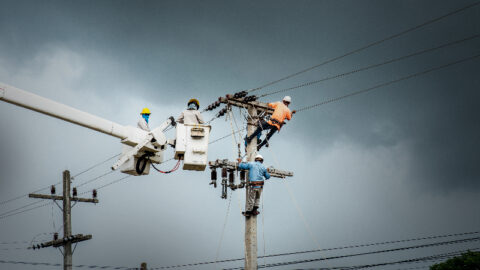Solar power, energy storage, smart control technology and microgrids are making continued inroads into the way we produce, use and sell electricity in Australia. For utilities to stay relevant to consumers, they need to be at the forefront of these new technologies. We spoke to Justin Harding, AusNet Services’ Distributed Energy and Innovation Manager, to learn more about the work they are doing in this space.
The penetration of solar power in Australia is growing rapidly – in 2017, Australia’s homes and businesses collectively reached the milestone of 6000MW capacity, enough electricity to power more than 1.8 million homes.
And with battery technology improving, it’s clear that this level of penetration will only continue to increase. The way consumers view and use electricity is changing – and for utilities to stay ahead of the curve, they need to start thinking beyond the traditional model of electricity generation and delivery.
As a result of the changing energy paradigm, solar and other distributed energy resources (DER) are a major focus area for AusNet Services, to empower communities and their energy future. The business has launched several initiatives in the space, from making the DER connection process easier for customers, to managing the technical impacts of integrating customer-driven DER into the network.
As we move toward the use of more DERs, microgrids, with their ability to enable cooperation between different resources, will be critically important.
Microgrids offer the prospect of localised resilience within the overall energy system, and we expect that the future of the grid will exhibit a diverse mix of projects that offer increased energy affordability, security and reliability,” said Mr Harding.
According to Mr Harding, a number of different parties within the AusNet Services electricity distribution network are actively investigating microgrid solutions. Some of the proponents include:
Community groups and organisations that are looking to achieve local emissions reductions or supply reliability improvements or both
Councils that are looking to deliver cost savings and increased energy resilience to communities and businesses
Property developers that are looking to add value and points of differentiation to their development projects
Renewables developers that are looking to invest in renewable energy projects
Energy retailers that are looking to retain customers and derive wholesale market benefits
Testing the waters
Given the importance of microgrids across the future grid, AusNet Services has established a significant project to gain a deeper insight into the impact microgrids will have.
The Mooroolbark Mini Grid is an innovation project testing a future scenario of high DER uptake combined with smart controls and optimisation.
It’s Australia’s first mini grid in an established community, and it explores how energy is utilised at both the household level and more broadly across the community, including both DER customers and non-DER customers.
“The project is providing us with technical insights as to the role that microgrids and other DER constructs can play more broadly across our network, and paves the way for network control schemes that can orchestrate fleets of DER,” said Mr Harding.
In March, the project recorded a significant milestone by successfully separating the houses that form the Mini Grid from the main power grid for almost 22 hours, while enabling a steady and secure power supply to customers by sharing renewable energy.
Only 14 of the 18 homes which separated from the main grid had solar panels and batteries. These are shared with the network, demonstrating the benefits power sharing can play during power outages.
The testing, which saw Mooroolbark Mini Grid isolated from the main grid for up to 22 hours was conducted over a two day period. Both days had maximum temperatures of 31°C. The relatively high temperature contributed to an increased cooling load for customers and also reduced the performance of the household battery systems. With cooler conditions or with higher performance batteries, AusNet Services believes a longer duration of islanded operation could have been achieved.
Over the course of the test, the mini grid generated 189kWh of solar energy, and consumed 220kWh across the entire 18 customers
Complete statistics around the power flows within the mini grid are summarised in Table 1.
The state of charge of the household batteries and that of the stabiliser battery across the test are shown in Figure 1. This demonstrates the successful orchestration of individual household batteries in order to maintain the stabiliser battery within a target window of state of charge.
While separated from the main grid, AusNet Services’ Distributed Energy Network Optimisation Platform (DENOP) was used in conjunction with GreenSync’s MicroEM solution to control the batteries and share the stored renewable energy among all 18 homes – even those without solar – before successfully switching all homes back to the main power grid.
During the trial, excess generation was absorbed into customers’ own battery systems. When all customer batteries filled up, the control system would then divert excess generation into the central community battery. If the central battery filled up the system would then signal the solar systems to reduce their power output in order to keep supply and demand balanced.
“As you can imagine, the suite of control systems that manage this process in real time need to be very sophisticated and our project team worked hard to achieve this capability,” said Mr Harding.
“This included close collaboration with our main partners GreenSync in deploying their microgrid control product, Power Technology Engineered Solutions in deploying their PowerCache microgrid stabiliser product, as well as our internal development of DENOP to manage data flows and deliver advanced control functions.”
The islanding tests at Mooroolbark were conducted with customers using power as normal. Mr Harding said that while it would have been possible to operate the microgrid for longer if customers limited their usage, the focus for this project was to prove the possibility of providing customers with increased levels of network service.
What this trial ultimately shows is that the process can be adapted over time to dramatically reduce the impact of power outages, especially in remote and rural areas. But Mr Harding said that while the trial has shown that local supply resilience is technically achievable, it has also shown that this constitutes a very different use of the distribution network.
This will require a step-change in the level of sophistication in AusNet Services’ network management and safety protection systems.
“More specifically, throughout the trial we needed to employ a voltage-based protection scheme in parallel to our legacy network over-current protection scheme, based on traditional circuit breakers and fuses,” said Mr Harding. “Therefore we expect to be closely involved in any customer driven microgrid projects that seek to provide backup supply capability.”
Microgrids: where to next?
The Mooroolbark trial has provided significant insight into the way microgrids operate and the role they will play in the AusNet Services’ network in the future, and according to Mr Harding, the utility is open to utilising a range of different types of microgrid in the future.
“The operating profile of the microgrid will ultimately depend on the purpose that the microgrid is serving and the technical capability of the equipment involved,” said Mr Harding.
“We are open to employing any type of generation within a microgrid, to the extent that the options are technically fit for purpose, economically attractive and acceptable to customers.
“In most cases solar power is the cheapest form of small-scale renewable generation, but there will be unique applications where wind, hydro, biomass or other forms of renewables will be suited.”
For example, AusNet Services has worked closely with the Warburton community and the Yarra Ranges Shire Council on a micro-hydro project, and has initiated some investigation into whether the hydro plant could in future form the base of a local microgrid.
According to Mr Harding, some projects will also be suited to the incorporation of non-renewable sources of generation, including hybrid systems of renewables and non-renewables working in tandem. Hybrid systems can leverage the benefits of both types of technology to deliver low emissions energy at an affordable cost.
“We also see the emergence and growth in ‘virtual’ microgrids,” said Mr Harding. “This involves the localised management of solar, battery and other energy resources to enhance individual customer and community benefits, while still being grid connected.
“These virtual microgrids are more about driving increased value from the distributed energy resources than about the resilience of their electricity supply, and have the benefit of generally not requiring the complexity and functionality of microgrids that can operate independently to the main grid.”
Looking at the ways microgrids will be able to isolate themselves from the main grid in the future, Mr Harding said there are no theoretical limits to how regularly a microgrid could disconnect or reconnect to the main grid. That said, in practice this would likely only be undertaken when there is a current or near-term network outage or blackout on the main grid, or when adverse weather conditions are imminent, such as risk of bushfires or storms.
Typically the connection and reconnection process can be achieved in a matter of seconds. Some individual customer backup battery systems can disconnect almost instantaneously, but entire microgrids would normally experience a short outage of less than a minute before re-establishing power.
“We are however currently collaborating with another of our technology partners ABB on developing a seamless disconnection process for large microgrids that could provide communities with uninterrupted supply,” said Mr Harding. “This is a leading edge field of investigation within the industry and we are very excited by the benefits that this could provide to our customers.”
The grid of the future
Moving forward, for AusNet Services, its future work in microgrids will focus on specific applications and value streams, such as managing increased levels of solar uptake, providing backup power to increase supply reliability to customers, and leveraging the capabilities of microgrids to provide cost-effective network services that can help reduce network costs for all customers, whether or not they have their own DER.
The organisation has also been active in supporting several project applications under the Victorian Government microgrid funding program and the ARENA funding round for Distributed Energy Resources.
“In terms of deploying microgrids more broadly, we are continuing to look for opportunities for microgrids or other non-network solutions to act as alternatives to traditional network projects,” said Mr Harding.
“A specific project that we are currently excited about is the potential to create a large-scale microgrid at a remote township at the fringe of our network.
“This microgrid would power the town from a local hybrid battery and diesel generator system in the event of a network outage that may be caused by extreme weather, animals or natural disasters”.
Microgrids can come in all shapes and sizes and there are no established definitions around how many customers constitute a nanogrid, microgrid or minigrid.
At the smallest end of the scale, a single customer that can power themselves independently of the grid can be considered to be a microgrid. This customer could be a residential customer or a large commercial facility or campus that has multiple sources of generation and multiple loads.
Clusters of houses in rural areas are often in the tens of customers and even at this small scale, there is value in the diversity of loads between customers such that it is much more economic to power the cluster as a microgrid rather than power each customer separately with stand-alone power supplies. This scale of project may be interconnected by the low voltage distribution network.
Townships may be in the order of hundreds or thousands of customers. Projects of this scale might need to involve the high voltage (22kV) distribution network.
It is even possible to form microgrids in the tens of thousands of customers, although the scale of generation required and the complexity in managing the system starts to blur the line between grid and microgrid.
“Whatever the scale of microgrid, the control system must ensure that supply always equals demand on a real-time basis,” said Mr Harding.
“There will indeed be times when there is excess generation within the microgrid, that if unmanaged, could cause power flows to become unstable or for assets to become overloaded.
“Rather than limiting the number of customers with generation, we would prefer to see a smart control system that dynamically manages the level of generation to keep the microgrid stable.”


















